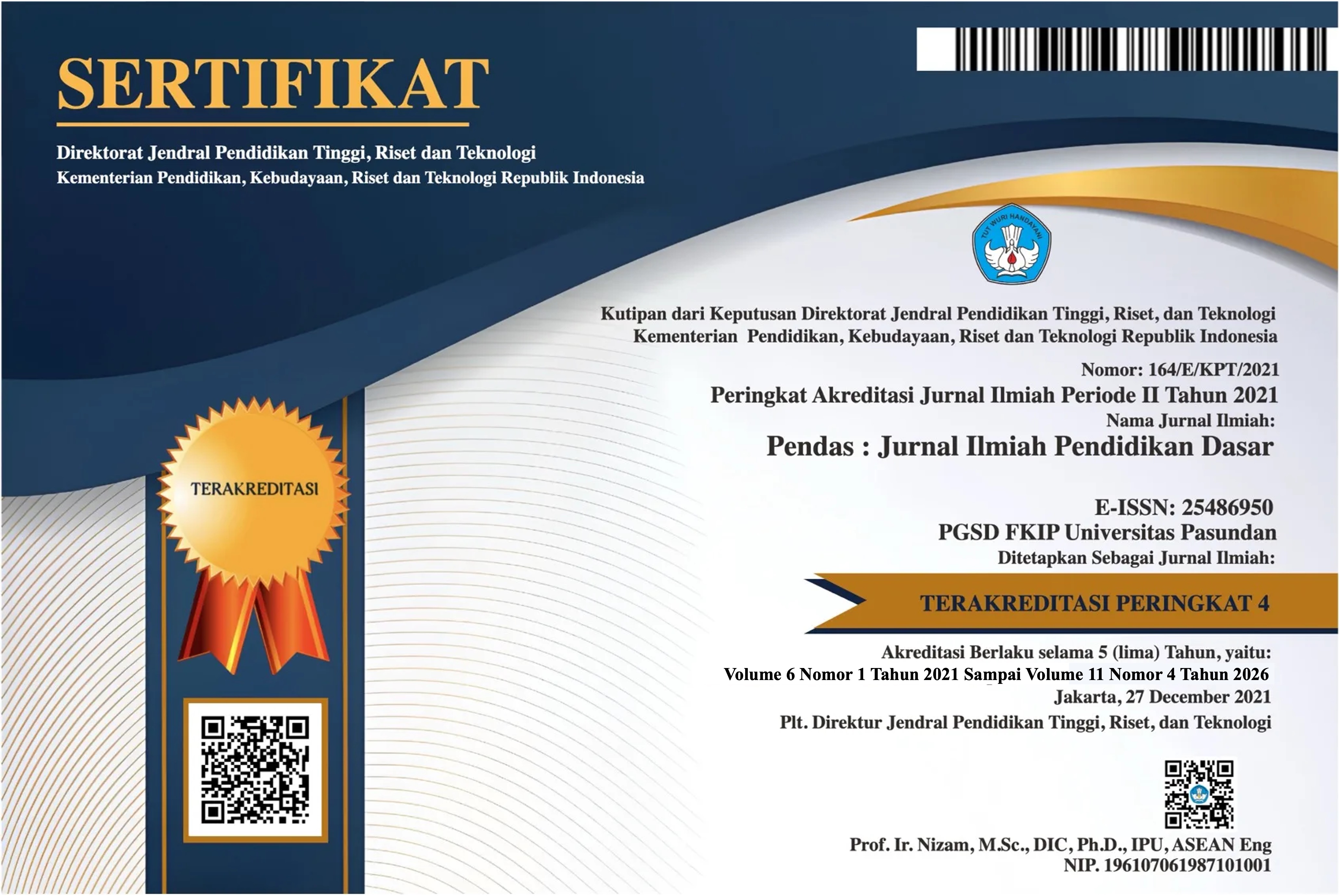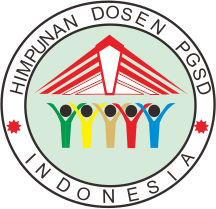PENGEMBANGAN E-MODUL BERBASIS MODEL GUIDED INQUIRY LEARNING PADA MATA PELAJARAN IPS KELAS VII SMP
Penelitian Pengembangan
DOI:
https://doi.org/10.23969/jp.v10i04.34985Keywords:
Development, E-Module, Guided Inquiry Learning ModelAbstract
This study was motivated by several facts found in the field. Students lack understanding of the material presented by teachers because the material is quite difficult to understand. This is due to the limited teaching materials used in social studies learning activities, which are not very interesting to students. There is also a limitation in the use of interactive teaching materials that can improve students' independent learning activities. In order to overcome these problems, E-Module teaching materials were developed to help make learning more interesting and to help improve students' understanding and willingness to learn independently. This study aims to produce a valid, practical, and effective E-Module for Grade VII social studies on Theme 4, “Turning Diversity into Strength,” to be used in the learning process.This research is a type of Research and Development (R&D). The model used in this development research is the Plomp development model. There are three stages in the Plomp development model, namely preliminary research (initial investigation), by conducting a needs analysis, prototype phase, by designing the social studies e-module product until it is valid and practical, and assessment phase, by testing its effectiveness. The validity test was conducted by three experts. The practicality test consisted of three stages, namely one-to-one evaluation, small group, and large class practicality. The effectiveness test was conducted in the seventh grade at Pertiwi Siteba Private Junior High School. The data type was primary data. The data collection instruments consisted of interviews, field observations, documentation, product validation questionnaires, student practicality questionnaires, educational practicality questionnaires, and multiple-choice test questions. The data analysis technique used descriptive analysis. The results of this study show product validation from subject matter experts with a percentage of 4.28 in the “highly valid” category, validation from media experts with a percentage of 4.85 in the “highly valid” category, student response questionnaires in the one-to-one evaluation with a percentage of 94.2% in the “highly feasible” category, small group evaluation with a percentage of 92.7% in the “Very Appropriate” category, and the results of the field test practicality with a percentage of 94.3% in the “Very Appropriate” category and the results of the assessment phase with a percentage of 78.26% in the “Good” category. The conclusion of this study is that the E-Module for Social Studies Based on the Guided Inquiry Learning Model for Grade VII Junior High School Social Studies is valid, practical, and effective for use in learning activities.
Downloads
References
Anori, S., Putra, A., & Asrizal. (2013). Pengaruh penggunaan buku ajar elektronik dalam model pembelajaran langsung terhadap hasil belajar siswa kelas x SMAN 1 lubuk alung. Pillar of Physics Education, 1(april), 104–111.
Anwar, Ilham. 2010. Pengembangan Bahan Ajar. Bahan Kuliah Online. Direktori UPI. Bandung.
Bobby Syefrinando (2016). “Pengembangan Media Pembelajaran Berbasis Macromedia Flash Professional 8”. Jurnal Ijer, Vol. 1 No. 2 ISSN: 2541-2132 (2016), h. 103.
Dick, W., Carey, L., & Carey, J. O. (2001). The Systematic Design Of Introction (Fifth Edition). Longman.
Doering, T., Pereira, l., & Kuechler, l. (2012). The use of e-textbooks in higher education: a case study. E-leader, june 4-6, 2012.)
Eko Budiono, Hadi Susanto (2006). Penyusunan dan penggunaan modul pembelajaran berdasar kurikulum berbasis kompetensi sub pokok bahasan analisa kuantitatif untuk soal-soal dinamika sederhana pada kelas x semester i sma (Jurnal Pend. Fisika Indonesia) Vol. 4, No. 2, Juli 2006
Fajrianti, R., & Meilana, S. F. (2022). Pengaruh penggunaan media animaker terhadap hasil belajar peserta didik pada mata pelajaran ips sekolah dasar. Jurnal basicedu, 6(4), 6630-6637.
Heni Jusuf, Ahmad Sobari (2021). Pelatihan Pembuatan Modul Pembelajaran Untuk Mendukung Pembelajaran Online (Jurnal Pengabdian Kepada Masyarakat TEKNO) Vol . 2 No. 1 (2021) 33 – 38
Kristianto, D. (2014). Pengembangan Media Pembelajaran Interaktif Melalui
Media Macromedia Flash Pada Materi Peluang Di Kelas Xi Ips Sma Negeri
1 Purbalingga. 312.
Kurniawan, Rudi, and Syafriani Syafriani(2021). Praktikalitas dan efektivitas penggunaan e-modul fisika SMA berbasis Guided Inquiry terintegrasi etnosains untuk meningkatkan berpikir kritis peserta didik. Jurnal Eksakta Pendidikan (Jep) 5.2: 135-141.
Miranti, S. G., Ramadhana, Y., & Gusmaneli, G. (2024). Pengembangan Modul Pembelajaran PAI Yang Menarik Dan Mudah Dipahami. Khatulistiwa: Jurnal Pendidikan Dan Sosial Humaniora, 4(2), 16-21.
Mustaji.2008. Pembelajaran Mandiri. Surabaya: Unesa FIP.
Nurhasana, P. D. (2021). Efektivitas media pembelajaran ips berbasis macromedia flash untuk meningkatkan motivasi dan hasil belajar siswa SD. (Journal Civics & Social Studies) 5(1), 80-89.
Nurul Isnaini (2022). Validitas dan Kepraktisan E-Modul berbasis Kontekstual Mata Pelajaran OTK Sarana dan Prasarana untuk Peserta Didik Program Keahlian Otomatisasi Tata Kelola Perkantoran (Jurnal Pendidikan Administrasi Perkantoran (JPAP)) Volume 10, Nomor 2
Okpatrioka, O. (2023). Research and development (R&D) penelitian yang inovatif dalam pendidikan. Dharma Acariya Nusantara: Jurnal Pendidikan, Bahasa dan Budaya, 1(1), 86-100.
Plomp, T., dan Nieveen, N. (2013): Educational Design Research Educational Design Research.
Riri Susanti (2017). Pengembangan Modul Pembelajaran PAI Berbasis Kurikulum 2013 di Kelas V SD Batu Basa, Tanah Datar Volume 2, No. 2, Juli-Desember 2017
Saidah, Rita Nur. (2017). Implementasi Model Pembelajaran Guided Inquiry untuk Melatihkan Keterampilan Pemecahan Masalah IPA Siswa SMP Kelas VIII Pada Materi Tekanan Zat Cair. Skripsi yang tidak dipublikasikan . Surabaya: Universitas Negeri Surabaya
Suarsana dan Mahayukti. (2013). Pengembangan E-Modul Berorientasi Pemecahan Masalah Untuk Meningkatkan Keterampilan Berpikir Kritis Mahapeserta didik. Jurnal Vol.2, No.2
Sudjana, N dan Rivai, A. 2013. Media Pengajaran. Bandung: Sinar Baru Algesindo
Sudjana, Nana dan Ahmad Rivai. 2007. Teknologi Pengajaran. Bandung: Sinar Baru Algesindo
Sugiyono. (2015). Metode Penelitian Kombinasi (Mix Methods). Bandung: Alfabeta.
Sugiyono. (2019). Metode Penelitian Kuantitatif, Kualitatif, dan R&D. Bandung:
Alfabeta.
Suparman, A. (1997). Desain Instruksional. Direktorat Jenderal Pendidikan Tinggi Departemen Pendidikan dan Kevudayaan
Downloads
Published
Issue
Section
License
Copyright (c) 2025 Pendas : Jurnal Ilmiah Pendidikan Dasar

This work is licensed under a Creative Commons Attribution 4.0 International License.


















